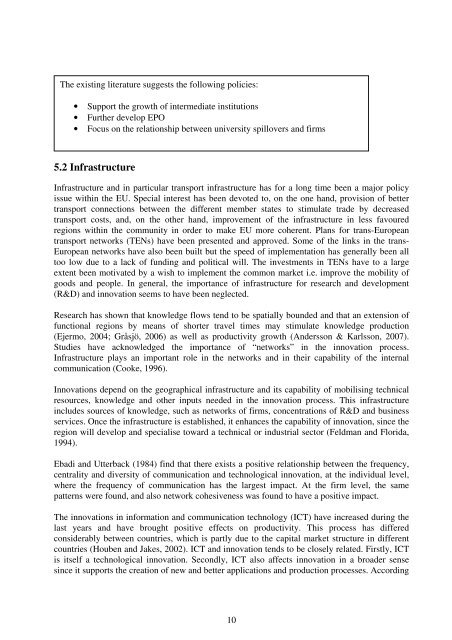INNOVATION POLICY INSTRUMENTS
INNOVATION POLICY INSTRUMENTS
INNOVATION POLICY INSTRUMENTS
You also want an ePaper? Increase the reach of your titles
YUMPU automatically turns print PDFs into web optimized ePapers that Google loves.
The existing literature suggests the following policies:<br />
• Support the growth of intermediate institutions<br />
• Further develop EPO<br />
• Focus on the relationship between university spillovers and firms<br />
5.2 Infrastructure<br />
Infrastructure and in particular transport infrastructure has for a long time been a major policy<br />
issue within the EU. Special interest has been devoted to, on the one hand, provision of better<br />
transport connections between the different member states to stimulate trade by decreased<br />
transport costs, and, on the other hand, improvement of the infrastructure in less favoured<br />
regions within the community in order to make EU more coherent. Plans for trans-European<br />
transport networks (TENs) have been presented and approved. Some of the links in the trans-<br />
European networks have also been built but the speed of implementation has generally been all<br />
too low due to a lack of funding and political will. The investments in TENs have to a large<br />
extent been motivated by a wish to implement the common market i.e. improve the mobility of<br />
goods and people. In general, the importance of infrastructure for research and development<br />
(R&D) and innovation seems to have been neglected.<br />
Research has shown that knowledge flows tend to be spatially bounded and that an extension of<br />
functional regions by means of shorter travel times may stimulate knowledge production<br />
(Ejermo, 2004; Gråsjö, 2006) as well as productivity growth (Andersson & Karlsson, 2007).<br />
Studies have acknowledged the importance of “networks” in the innovation process.<br />
Infrastructure plays an important role in the networks and in their capability of the internal<br />
communication (Cooke, 1996).<br />
Innovations depend on the geographical infrastructure and its capability of mobilising technical<br />
resources, knowledge and other inputs needed in the innovation process. This infrastructure<br />
includes sources of knowledge, such as networks of firms, concentrations of R&D and business<br />
services. Once the infrastructure is established, it enhances the capability of innovation, since the<br />
region will develop and specialise toward a technical or industrial sector (Feldman and Florida,<br />
1994).<br />
Ebadi and Utterback (1984) find that there exists a positive relationship between the frequency,<br />
centrality and diversity of communication and technological innovation, at the individual level,<br />
where the frequency of communication has the largest impact. At the firm level, the same<br />
patterns were found, and also network cohesiveness was found to have a positive impact.<br />
The innovations in information and communication technology (ICT) have increased during the<br />
last years and have brought positive effects on productivity. This process has differed<br />
considerably between countries, which is partly due to the capital market structure in different<br />
countries (Houben and Jakes, 2002). ICT and innovation tends to be closely related. Firstly, ICT<br />
is itself a technological innovation. Secondly, ICT also affects innovation in a broader sense<br />
since it supports the creation of new and better applications and production processes. According<br />
10
















